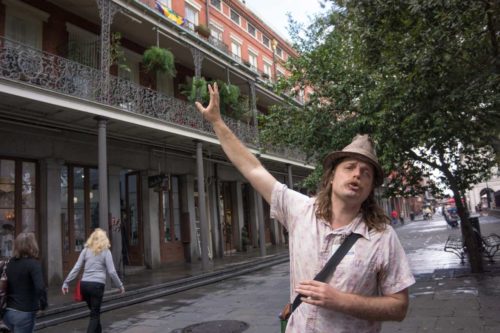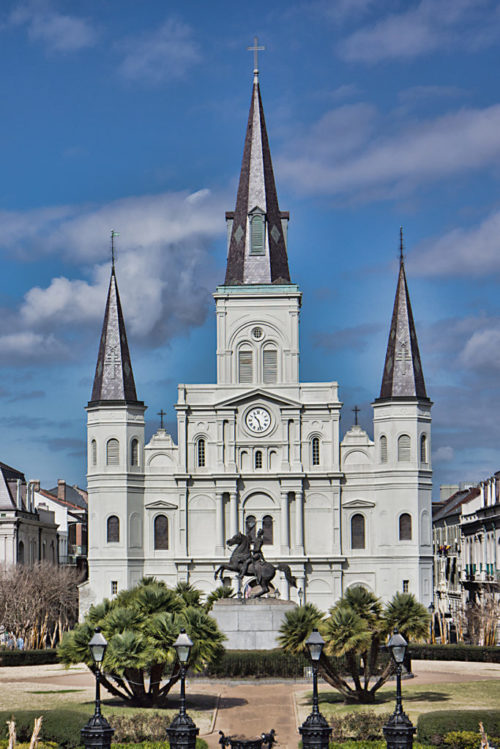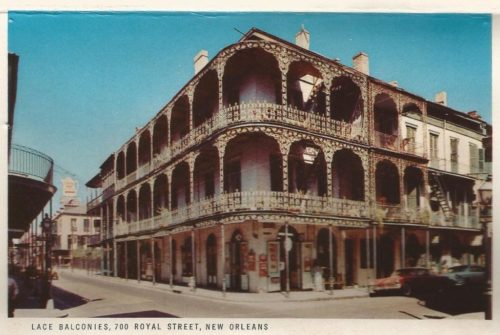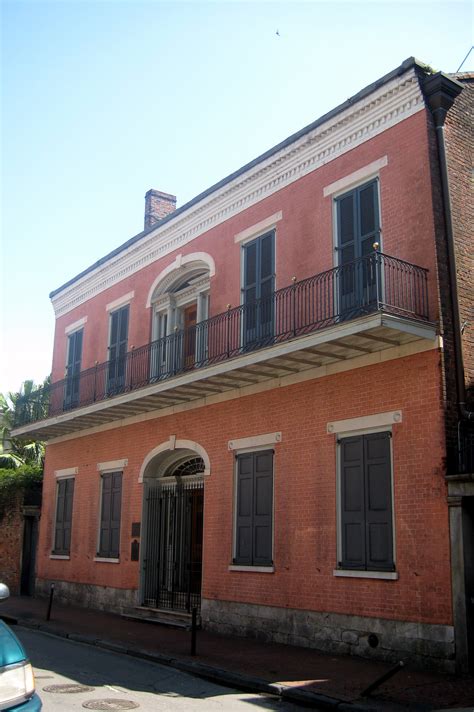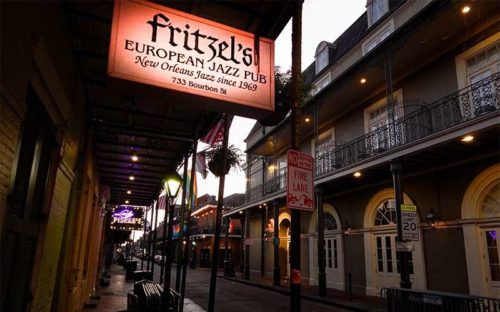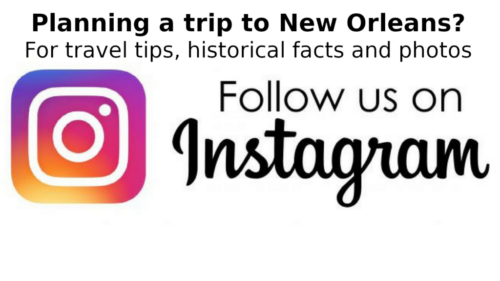Free Self-Guided Walking tour of The French Quarter with Map
Cost: Free
Starting Point: 800 Decatur, Cafe Du Monde
Ending Point: 941 Bourbon Street, Laffite’s Blacksmith Bar
Total Distance: A fourth of a mile
Time Required: About an hour or two
Best Time To Go: Early morning is the best time to avoid crowds and heat
Getting Here: The French Quarter is easily accessible by rideshare or public transportation. Parking is difficult, expect to pay. Our Tour starts in the heart of The Quarter right by Cafe Du Monde.
We’re excited to have you on this free self-guided walking tour of The French Quarter!
When you hear ‘Bourbon Street,’ partying, booze, and tourist traps may come to mind, but it is more than that. The French Quarter is a unique, magical place, that is also a mostly intact historic neighborhood that has been around for over 300 years!
Let us show you precisely what makes us fall in love with The French Quarter over and over, every day of our lives, fueling us to do what we do!
Once you’ve fallen in love too, join us for our free “pay what you feel” daily tour that starts at 10 AM daily and leaves from 768 Decatur, right next to Cafe Du Monde.
Start your French Quarter tour at the world famous Cafe Du Monde.
Synonymous with New Orleans, the original Cafe Du Monde was established in 1862. There is almost always a line, but don’t get discouraged because it moves quickly, and we promise it’s worth it!
Cafe Du Monde serves dark roasted Coffee with Chicory, Beignets, White and Chocolate Milk, and fresh-squeezed OJ. The coffee here is served Black or Au Lait (mixed half and half with hot milk), and the world-famous beignets covered with powdered sugar.
Our Free French Quarter Tour meets next door, and we often judge how busy The Quarter is by how long Cafe Du Monde’s line is!
Pro Tip:
Want to skip the crowds? You’re in luck- Cafe Du Monde is open 24/7, so come back after dinner or before a late-night on Bourbon street.
You can sip on your Cafe Au Lait Cafe while watching street performers and taking in the fantastic view! Located across the street from Decatur Street from Jackson Square, the Washington Artillery Park and Terrace has spectacular views of the Square, with Saint Louis Cathedral in the background. Behind you, along the Mississippi, is the riverwalk (officially named Moonwalk Park), one of the best places to walk or jog around New Orleans.
Pro Tip:
Watch out for locals asking where you got your shoes (Answer: they’re on your feet!)
The Mississippi is the second-longest river in North America, starting at Lake Itasca in Minnesota and disappearing into the Gulf of Mexico in Southern Louisiana. The Mississippi reaches almost 200 deep in The French Quarter, the deepest part of the entire river! It is the reason the city was built.
Indigenous people have made a home along the Mississippi River for thousands of years, using it as a highway and source of fish. The Europeans came during the 16th century, and the river was a barrier, forming borders for New France, New Spain, and the United States. In the 19th and 20th centuries, steamboats took over the space to transport agricultural and industrial goods.
Learn more about New Orleans’ early history in our video.
Pro Tip:
A short, 15-minute walk from here, you’ll find the Outlet Mall at Riverwalk, near Canal Street, and a nearby artists co-op (912 N Peters).
Named after former New Orleans mayor Maurice Landrieu (Moon) for his significant role in creating the riverside boulevard, Moon Walk is a mile-long paved promenade along the Mississippi River.
Moon Walk is a popular place for locals and tourists alike, filled with artists, musicians, and street performers, plus some of the best views of New Orleans and the Mississippi.
Relax on the benches that line the river and watch steamboats, cruise ships, and container ships roll past. The Moon walk is a great place to stroll,
find out about the best places to walk, hike and jog in New Orleans
How to access the Moon Walk
Use St. Philip, Dumaine, St. Peter, Toulouse, St. Louis, Conti, and Bienville Streets or Washington Artillery Park to get to the Moon Walk.
Monuments along the Moon Walk
“Monument to the Immigrants,” a statue by Franco Allesandrini
“Old Man River” by Robert Schoen
The Holocaust Memorial by Israeli sculptor Jacob Agam
Since the beginning New Orleans has had one central square or gathering/meeting place. Originally Place d’ Armes, a muddy square where the French military paraded and public executions occurred. Today that dirt patch is the world-famous Jackson Square. In 1850, Baroness Micaela Almonester Pontalba redesigned the square in the style and spirit of the parks and gardens of Paris and renamed it in honor of Andrew Jackson. She redesigned the Square around the statue of Andrew Jackson, with circular paths surrounding the General in the center. And what was once a muddy field became Jackson Square, named after General Andrew Jackson, who led the city to victory in The Battle of New Orleans.
Today’s Jackson Square
Today, Jackson Square is still a vibrant place and the center of the French Quarter. The fence around the Square is filled with artists selling their crafts and fortune-tellers waiting to show you the future at any time of the day or night. Jackson Square has appeared in The Curious Case of Benjamin Button, K-Ville, and The Originals.
What is the Vieux Carré?
Vieux Carre (Pronounced “VOO car A”) is the original name of The French Quarter. French for “old square,” a reference to Jackson Square. The Vieux Carre only came to be known as The French Quarter after the Louisiana Purchase encouraged Americans to move to the city, who noted its distinctly French creole flair and started called this part of town “The French Quarter”.
Pro Tip:
All the art is original and makes for impressive and authentic souvenirs. Artists who sell their crafts in Jackson Square are licensed by the City of New Orleans. Most artists will ship if you don’t want to risk damaging your new masterpiece on the return flight home.
With Dectuar street at your back ahead of you will see our next stop The Presbytere which is the building to the right of the cathedral. Constructed in 1813 to match the Cabildo, The Presbytere was initially called Casa Curial (“Ecclesiastical House”) and intended to house clergy; however, it was never used as a religious residence. Eventually, The Presbytere would be absorbed as part of the Louisiana State Museum and declared a National Historic Landmark. Today, you’ll find exhibits that tell two sides of the Louisiana story: one of celebration (Mardi Gras: Its Carnival Time in Louisiana) and one of resilience (Living with Hurricanes: Katrina and Beyond).
You’ll notice the prestigious Cabildo right away. It is to the right of The Presbytère and is nearly identical. This elegant Spanish Colonial building is home to rare and cherished pieces of New Orleans history and is itself a piece of history. Built around 1795, The Cabildo has been the site of several pivotal US moments, such as the Louisiana Purchase, which finalized the US acquisition of Louisiana, and the definitive landmark Plessy v. Ferguson Case, which was a challenge to the segregation in the late 19th century.
Today, the Cabildo Museum proudly showcases the history of The French Quarter, New Orleans, and Louisiana, emphasizing diversity of the people of New Orleans.
The red brick, four-story-tall Pontalba Buildings divide the two sides of Jackson Square, watching over the artists and their patrons.
Designed and constructed by businesswoman Baroness Micaela Almonester Pontalba, the two Parisian-style houses have custom-made cast-iron railings featuring her monogram. Other cast-iron galleries in the Quarter were shipped into town from the east coast.
These galleries were typical everywhere in the US by the 19th century but now are uncommon. They are now refereed to as ‘lace balconies’ in New Orleans as they resemble lace.
On the Pontalbas bottom floor, you’ll find restaurants and shops, and on the upper floors, you’ll find apartments, the oldest (continuously) rented apartments in the US, to be exact.
Part of the Lower Pontalba Building, the 1850 House offers a rare glimpse into New Orleans’ posh Antebellum period. Owned by the Louisiana State Museum, the 1850 House is furnished to represent life in mid-nineteenth-century New Orleans.
As former apartments, the residents of this house changed every few years, and the current 1850 House displays do not represent any individual family but rather the antebellum period in general.
The museum is a summary of one of New Orleans’ most prosperous periods and is designed to show the daily life of the upper-middle class during that time.
You have probably already noticed one of New Orleans’ most notable landmarks. The mystical Saint Louis Cathedral, whose presence watches over Jackson Square, visible at nearly every corner. Built in 1794 St Louis Cathedral is the oldest cathedral in the United States.
With three steeples proudly towering above its historic neighbors (The Cabildo and The Presbytere), the Saint Louis Cathedral is the oldest cathedral in the United States. Notice the bell embossed at the center with the name “Victorie” in commemoration of The Battle of New Orleans victory in 1815.
Rumors of Hauntings
The Saint John Cathedral is said to be haunted by Dr. Antonio de Sedella (Pere Antoine), who was a priest whose body is buried within the cathedral. During Christmas Midnight Mass, the Dr. appears holding a candle near the altar.
Touch Down Jesus
Added to the cathedral in 1926, The Sacred Heart of Jesus statue was sculpted in Italy and is one of the most photographed statues in the city, viewable behind the cathedral from Royal Street.
At night, lit by the glow of the cathedral, the statue casts a shadow that resembles Jesus with his arms raised like a football referee signaling a touchdown. This has earned the Sacred Heart of Jesus Statue to be dubbed ‘Touch Down Jesus’ by locals and has become heavily associated with the New Orleans Saints.
Tennessee Williams lived on the top floor with his boyfriend, Pancho, from 1946-to 1947 and wrote his most famous work here, ‘Streetcar Named Desire.’
The New Orleans streetcar would run right past Tennessee Williams’ house down Royal street to Desire street, a clear inspiration for the play.
Today, 632 ½ Peter Street is a residential apartment building, so take extra care and be respectful when viewing and refrain from yelling “STELLA!”
619 Chartres Street was the spot where the Great New Orleans Fire of 1788 started. The Great Fire began at 1:30 PM on Good Friday and destroyed almost the entire city within five hours.
As the city was rebuilt, wooden buildings and homes were replaced with masonry structures that now make up Jackson Square, such as St Louis Cathedral, the Cabildo, and the Presbytere. It is for this reason most of the French Quarter you see today was built between 1800-1860
Step away from the famous Bourbon Street to experience the finer things (and shopping!) in life on Royal Street.
Royal Street is the quiet and refined section of the Quarter, a shopper’s paradise with family-owned art galleries, rare antique shops, upscale jewelry, and themed boutiques.
Royal Street is one of the most prestigious and expensive places to shop in the US, so take time to browse the galleries and admire the refinement. Keep your eyes peeled for spontaneous street performers!
Pro Tip: Street Performers on Royal Sreet
Street performers are usually set up on the street along Royal Street. Royal Street is closed to vehicular traffic 11 AM-4-PM on weekdays and 11 AM-7 PM on weekends. With no cars, it’s much easier for pedestrians to safely shop and explore Royal Street during those hours.
One of our favorite performers is Doreen, who plays the clarinet like nobody’s business; Doreen is out almost every Saturday on the corner of Royal and St. Louis outside the Rouses.
If you’ve ever seen a photo of the French Quarter, you’ve likely seen the iconic LaBranche House. Constructed in the 1830s and turning heads for just as long, the LaBranche House is one of the Quarter’s most photographed buildings. Romantic cast-iron galleries, an elegantly curved shape, and a distinctly whimsical look define the LaBranche House.
The ghosts of LaBranche House
Like most beautiful buildings in the French Quarter, the LaBranche House is surrounded by rumors of hauntings. Built by Jean Baptiste LaBranche, who died before its completion, the house is said to be haunted by Mr. LaBranche’s secret mistress and wife.
After his death, Mrs. LaBranche found out about his mistress and invited her over for tea. The mistress was drugged and chained to the third floor, dying slowly, her body found 15 years later.
It’s said that the ghosts of both these women haunt the building, still feuding.
More than just a restaurant, The Court of Two Sisters is a must do. It is a famous buffet in New Orleans, absolutely adored by locals and tourists alike! It is a great way to try many of the most famous New Orlean’s signature dishes all at once.
Built during the city’s first economic boom in 1832, the Court of Two Sisters is named for the two sisters that came to inherit it from their father and ran a general store here for many years. It is known for its daily jazz brunches and authentic creole buffet. Take your time and enjoy the beautiful New Orleans courtyard
The building also has boutique shops, a small bistro, a refreshment stand, and a speakeasy, that are all worth exploring.
Here’s a one-sentence horror story:
Back in the 19th Century, anyone could apprentice for six months at a Pharmacy and then begin selling their concoctions without any regulations.
During this time, Opium was a standard treatment, as was bloodletting. The wealthy were given pills coated in gold as a “cure-all.” The pills would pass through their bodies often to be retaken once removed from their chamber pots!
These days, the Pharmacy Museum provides educational programs to preserve the past and explain the history of pharmacology in Louisiana.
You may wonder how anyone survived during the 19th century as you tour the Pharmacy Museum! The answer is the smart ones didn’t go to the doctor.
Consider a self-guided tour through the museum to see outdated concoctions strange looking medical instruments and gain a better appreciation for today’s healthcare. Currently open for Self Guided Tours: Weds-Sunday 12pm-5pm check out their website for more info
Hauntings at the Museum
Dr. Gupas, who “imposed shocking experiments on pregnant slaves,” is said to haunt the pharmacy after it closes. There is also a young boy and girl that appear in the courtyard, who are thought to be The Dufilho children.
Pro Tip: We consider The Pharmacy Museum a must do for everyone visiting the French Quarter.
At over 200 years old, Napoleon House is both a National Landmark and one of the most famous bars in the US.
Napoleon was once offered refuge by the mayor of New Orleans, who lived at 500 Chartres in 1812. Although Napoleon never lived there, the name stuck with the house.
One of the best examples of French architecture in the Quarter, Napoleon House is the perfect place to sip craft cocktails in a palm-shaded courtyard.
If you’re ready for a pick-me-up, grab some red beans and rice, or try a “Primm’s Cup,” a gin-based fruit cup. We also love the muffuletta, a great way to explore the Italian influence in New Orleans.
Established in 1946, Brennan’s Restaurant has perfected the art of blending savory Modern French and Traditional Creole dishes. The happy, pink-colored building is a staple of Royal Street.
The Bananas Foster was born at Brennan’s, created by Ella Brennan and Chef Paul Blangé in 1951. As a hub for Central America, the Port of New Orleans saw an influx of bananas in the 50s, so Owen Brennan challenged Chef Blangé to include bananas in a dish to promote the fruit. The desert was named after Richard Foster, chairman of the New Orleans Crime Commission and friend of Owen Brennan.
Today, Brennan’s Restaurant is said to be extremely haunted. Chef Paul Blangé is known to appear if you order his signature Bananas Foster. The chef is also said to bang together pots and pans at closing time, heard from Royal Street outside the restaurant’s closed doors.
Pro Tip:
Brennan’s Restaurant accepts reservations up to 30 days in advance and usually books immediately.
Established in 1840 by Antoine Alciatore, Antoine’s Restaurant is one of the oldest family-run restaurants in the US, passed down through five generations. Besides the award-winning French-Creole food, Antoine’s is known for its prestigious patrons, including US Presidents and Pope John Paul II.
Originally only in French, now also in English, the menu includes famous recipes born in the restaurant itself.
Dishes born at Antoine’s Restaurant:
Oysters Rockefeller
Pompano en papillote
Eggs Sardou
Pigeonneaux Paradis
Antoine’s Cookbook, compiled by fifth-generation descendant Roy F. Guste, has hundreds of original recipes from Antoine’s Restaurant.
Despite what you’ve heard we think you can’t tour The French Quarter without stopping on Bourbon Street!
For many, Bourbon is what they envision when they think of New Orleans. People swarm the area for the many bars and strip clubs; Bourbon Street sees millions of yearly visitors.
People judge Bourbon Street, and yes, it can get trashy, and yes, it is full of drunks and strip clubs, but it has a fascinating history, and everyone should at least look at it once, preferably during the daytime.
During “the golden age” in the 1960s, clubs acquired high returns by utilizing “B-Girls.” These girls were hired to wander the gambling backrooms and flirt with men to rack up high tabs.
Unknown to the men buying their drinks, the women would be drinking colored water instead of actual brandy (this is where the name B-Girls came from). After ordering several drinks, the women would split, leaving the man with nothing more than a hefty bill to pay.
We wrote an excellent guide to “Things to do in the French Quarter” which includes a list of must do to stops on Bourbon Street
Built in 1831, the Hermann-Grima Historic House is almost 200 years old and is mostly original. It includes slave quarters and an exquisite courtyard.
For the 15th anniversary of the Hermann-Grima Historic House, the museum opened an exhibit called Urban Enslavement in New Orleans, which is well worth a visit.
Pro Tip:
We think that the Herman Grimma house is one of the best options in the French Quarter for a historic home tour.
Here on the corner of Dauphin and St Louis street is one of the newest additions to the French Quarter. Before historic preservationists put rules in place protecting buildings in the French Quarter, Texaco Oil built a modern “for the times” service station here in 1925.
In 1996 new owners were allowed to demolish the property and build a new single-family home because it was designed to resemble a 19th-century creole townhome with its French Quarter style brick and stucco walls and romantic cast iron Galleries.
Completed in 2001, 500 Dauphine Street is one of the newest buildings in the French Quarter.
Take a close look at it. Now look at its neighbor at 835 St. Louis-both are Creole townhomes.
Can you tell the difference?
The Xiques House is a historic Greek Revival mansion built in 1852 by J.N.B de Pouilly, New Orleans’s most celebrated antebellum architect.
521 Dauphine makes a statement, towering over the surrounding buildings with elegant pillars. This is one of the few Greek Revivals in The French Quarter, although The Garden District has plenty.
Pretty easy to spot with it’s impressive towering cast iron galleries. Gardette-LePretre Mansion is one of the tallest buildings in the French Quarter today. It was Built for a dentist in 1837. Can you imagine going to a dentist in 1837? absolutely terrifying! Today this is a 6 unit apartment building.
Fritzel’s European Jazz Pub is the oldest jazz club on Bourbon Street!
Along with Preservation Hall on St. Peter Street, Fritzel’s is one of the few places on Bourbon Street to catch live jazz music nightly. It opened in 1969. Fritzel’s has a much more laid-back atmosphere than the rest of Bourbon Street, so stop by, grab a drink and enjoy getting lost in the music. If you’re a jazz fan, this place will light your soul on fire.
Want to watch more live music while visiting New Orleans? Check out our Guide to Live Music in New Orleans.
OZ is the #1 LGBTQ dance club in New Orleans, located on Bourbon Street. Featuring different events every night of the week, this 21+ dance club has two floors with a classic Bourbon Street balcony for people watching.
Expect a friendly crowd, loud music, a full bar, and a balcony that you can sit on for that classic New Orleans Bourbon Street balcony bucket list experience.
Across the street is The Bourbon Pub, another gay bar/dance club. This stretch of Bourbon Street is historically a gay neighborhood.
Cafe Lafitte is the oldest LGBTQ bar in the south opened by Roger Caplinger after he lost the original Cafe Lafitte’s (currently Lafitte’s Blacksmith shop) in a tax sale. This is considered by many the oldest gay bar in the south. Tennessee Williams and Truman Capote were frequent patrons of the cafe. Many of the people who renovated, restored, and saved the properties in the French Quarter were gay men who frequented this bar “back in the day”.
While its claim as the oldest bar in America is debatable (the building didn’t open as a bar until the 1940s), Lafitte’s Blacksmith Shop Bar is likely the oldest building in America with a bar in it.
Named for the Pirate Lafitte, whose brother owned this shop at the height of their Piracy and smuggling operation and were believed to use the business as a front for their pirate operations.
This location used to be Cafe Lafitte, which Roger “Tom” Caplinger opened during the late 40s. Caplinger was big in the queer community and hosted drag shows attended by the likes of Truman Capote, Noel Coward, and Tennessee Williams.
Caplinger never held the deed to the location, and the cafe was sold in 1953. Not to be deterred, Caplinger bought another building and named it Cafe Lafitte in Exile, a block away from the current Lafitte’s Blacksmith Shop Bar in the early 1960s.
Lafitte’s Blacksmith Shop is exclusively lit by candlelight, complimenting the live piano music. That’s our tour, so sit down and get yourself a drink or read on for tips for things to do and where to eat.
Pro Tip:
The “Voodoo Daiquiri” or “purple” drink is highly recommended for first-timers, especially on hot days. It’s rumored that the ghost of Lafitte himself occasionally appears near the fireplace.
Where to Watch Street Performers
The best place to find street performers in The French Quarter are:
Royal Street – Musicians perform at all times of the day. From poets to hire to solo blues guitarists, instrumental guitar/violin duets, gypsy jazz, and more, this is the heaviest concentration of street musicians in The French Quarter.
Frenchman Street – there are over a dozen venues with live music to be heard indoors.
Jackson Square – stop in front of the Presbytere and the Cabildo, where it’s commonplace to encounter a brass band or two, violinists, or even a lone saxophonist.
Take a Free Music Tour- We at Nola Tour Guy have put together a Free Guide on where to see live music in New Orleans. We cover all the best music joints in the Crescent City.
After exploring the history and magic of The French Quarter, relax the New Orleans way: with a crafted cocktail, preferably in a romantic courtyard or patio. Here are some of the must-try cocktails that The French Quarter is known for:
The Hurricane
The Hurricane is a sweet red cocktail traditionally served on ice. Created during World War II, the name comes from the shape of the glass it was originally served in, which resembles a hurricane lamp. Pat O’Brien’s is where it was born! The courtyard at Pat’s is a must-do; with dueling pianos and a timeless atmosphere, you won’t be disappointed. Note: the Hurricane doesn’t taste strong, but it is. Take it slow to avoid feeling like you got hit by a hurricane the next day.
The Sazerac
Created in 1835 by Antoine Peychaud, the Sazerac is the first official cocktail in the world. The drink is rye whiskey, bitters, and Absinthe, so it was banned in 1912 when Absinthe was made illegal in the United States. Herbsaint, an anise-flavored liqueur, was created as a substitute in 1934 by a local company so New Orleanians could still enjoy this cocktail. Enjoy this potent concoction at the Sazerac Bar. Use Sazerac the intended way- a digestif, an after-dinner drink to aid digestion.
Vieux Carre
Vieux Carre is a classic French Quarter cocktail, first mixed in 1938. Try this traditional drink at the famous rotating Carousel Bar in the Hotel Monteleone, where it was created! This cocktail is a compelling blend of whisky, cognac, vermouth, and bitters.
Gin Fizz
Henry C. Ramos first mixed the Gin Fizz in 1888 at Meyer’s table D’Hotel Internationale. The frothy cocktail needs fifteen minutes of vigorous shaking, which required Ramos to hire “shaker boys” due to the high demand. Louisiana Governor Huey Long loved this drink so much that he brought his bartender with him when traveling to New York so he wouldn’t be without his favorite drink. Ramos sold the rights to the Roosevelt Hotel after the Prohibition, so if you want the original version, this is your stop.
French 75
Created in World War I, the French 75 is named after the French military’s M1897 rapid-fire 75mm artillery gun because it packs such a powerful kick. This simple Champagne cocktail has a light citrus taste and can replace a typical mimosa with so many variations available.












